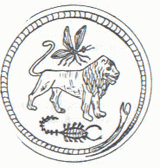Search Results
7/9/2025, 10:44:39 AM
>>509904587
>Ahriman creates all evil creatures, such as scorpions, toads, and vipers, and destructive forces, storms, drought, disease, and death, and destroys vegetation, the fire, the bull and Gayormart. Then the spiritual beings bound Ahriman and carried him off to Hell. Ahura Mazda now brings about the resurrection, and from the corpse of the Bull the sterile land is fertilized, the fire is rekindled, and from the dead Gayomart creates the ancestors of mankind. The first couple have free will and at first choose to serve Ahura Mazda, but Ahriman tempts and deceives them, introducing corruption into the world. And the war goes on, dominating man’s history until the coming of Zoroaster, whose advent begins the final period to last until the Day of Judgment, with the coming of the saviour, when a flood of molten metal shall burn the wicked, while the righteous will pass unharmed, and good and evil are finally separated from one another
>An important testimony of the religious situation in the Sassanid empire refers to three religious currents in Iran, the first of which advanced a system of three principles — the good, the just and the evil, an obvious reference to Zurvanism: the good principle being Ohrmazd; the just, Zurvan; and the evil, Ahriman. The other two currents were respectively the doctrine of the two principles — clearly dualist Zoroastrianism — and that of the seven principles, which still eludes identification. Besides the strict Zoroastrian dualism, elevated to the status of orthodoxy in the Sassanid empire, there also existed a ‘monotheistic’ version of Zoroastrianism, according to which it was a supreme God that had created Ahriman and the world was thereafter subjected to their dual treatment, the good deriving from God and the evil from Ahriman. Another Zoroastrian trend during the Sassanid era sought the origin of Ahriman ina transformation in the good principle, an ‘evil thought’ that gave rise to its evil opposite.“
>Ahriman creates all evil creatures, such as scorpions, toads, and vipers, and destructive forces, storms, drought, disease, and death, and destroys vegetation, the fire, the bull and Gayormart. Then the spiritual beings bound Ahriman and carried him off to Hell. Ahura Mazda now brings about the resurrection, and from the corpse of the Bull the sterile land is fertilized, the fire is rekindled, and from the dead Gayomart creates the ancestors of mankind. The first couple have free will and at first choose to serve Ahura Mazda, but Ahriman tempts and deceives them, introducing corruption into the world. And the war goes on, dominating man’s history until the coming of Zoroaster, whose advent begins the final period to last until the Day of Judgment, with the coming of the saviour, when a flood of molten metal shall burn the wicked, while the righteous will pass unharmed, and good and evil are finally separated from one another
>An important testimony of the religious situation in the Sassanid empire refers to three religious currents in Iran, the first of which advanced a system of three principles — the good, the just and the evil, an obvious reference to Zurvanism: the good principle being Ohrmazd; the just, Zurvan; and the evil, Ahriman. The other two currents were respectively the doctrine of the two principles — clearly dualist Zoroastrianism — and that of the seven principles, which still eludes identification. Besides the strict Zoroastrian dualism, elevated to the status of orthodoxy in the Sassanid empire, there also existed a ‘monotheistic’ version of Zoroastrianism, according to which it was a supreme God that had created Ahriman and the world was thereafter subjected to their dual treatment, the good deriving from God and the evil from Ahriman. Another Zoroastrian trend during the Sassanid era sought the origin of Ahriman ina transformation in the good principle, an ‘evil thought’ that gave rise to its evil opposite.“
Page 1
